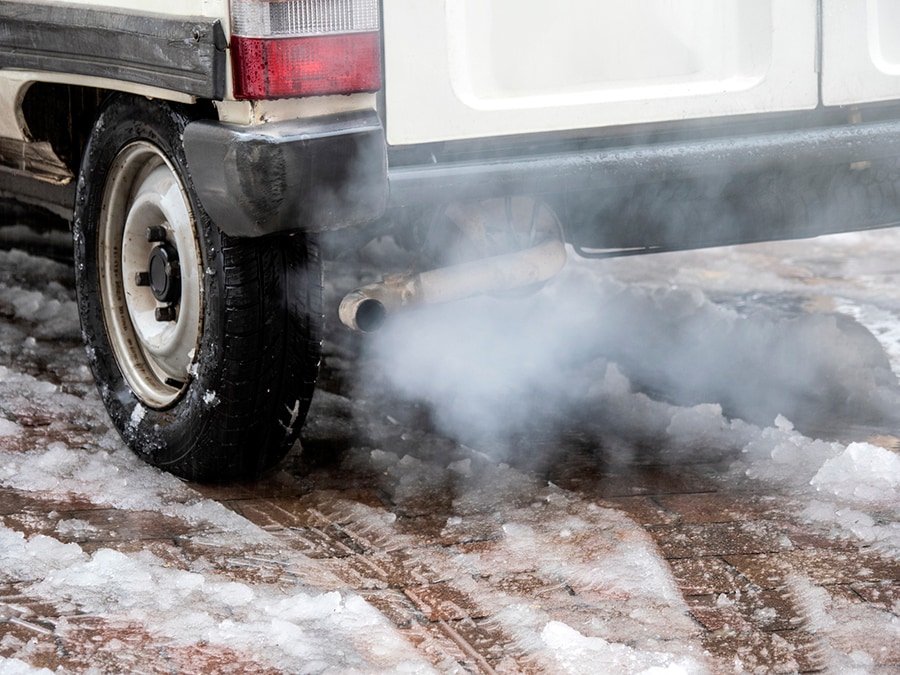It’s true that carbon monoxide and carbon dioxide have some things in common, but they are not interchangeable. It’s important to know the differences between these odorless gasses so you’ll know what causes each one and just how dangerous they are to you.
So, what’s the difference between carbon monoxide and carbon dioxide?
Carbon monoxide is a colorless, odorless, tasteless gas. Carbon monoxide occurs when gasoline, charcoal, coal, wood propane or other fuel is burned.
Carbon dioxide is also a colorless, odorless gas. It’s formed when carbon-based fuels are burned, like coal, and it comes from animal and plant respiration and decomposition.
Despite their similarities, there are some key differences, too.
Differences Between Carbon Monoxide (CO) and Carbon Dioxide (CO2)
Carbon Monoxide (CO) |
Carbon Dioxide (CO2) |
Has one carbon atom, and one oxygen atom |
Has one carbon atom, and two oxygen atoms |
Flammable |
Non-flammable |
Slightly lighter than air |
Heavier than air |
Over 400 people die per year from CO gas poisoning |
Around 90 recorded fatalities per year happen from CO2 gas poisoning |
Not produced from human, animal or plant respiration |
Humans, animals and plants produce CO2 from respiration |


Where does carbon monoxide come from?
As we mentioned earlier, CO gas is a colorless, odorless, tasteless gas found in many home appliances. When ventilated properly, CO poses little risk to your health.
Owning and maintaining a carbon monoxide alarm is always a good idea, but you should also know what produces CO in your home and how to recognize carbon monoxide poisoning symptoms.
How does carbon monoxide poisoning happen?
The most common causes of carbon monoxide poisoning include malfunctioning or improperly ventilated appliances. If these appliances leak CO gas into your home, dangerous levels can accumulate and cause carbon monoxide poisoning.
This is especially deadly when it happens inside an enclosed space, like your home or garage.
If you believe you or someone in your family has CO poisoning, immediately call emergency personnel or go to the hospital for treatment.
What gives off carbon monoxide in the home?
You help produce carbon monoxide when you burn charcoal, use a camping stove or smoke a cigarette.
Other things that give off CO include:
- Various gas-operated appliances like your stove and oven
- Vehicles
- Boilers
- Water heaters
- Furnaces or chimneys
- Clothes dryers
- Central heating systems and air conditioning units
- Generators or other gas-powered items like grills or lawn equipment
- Fireplaces or other open fires
What are some symptoms of carbon monoxide poisoning?
Carbon monoxide poisoning usually happens slowly, over several hours of CO exposure. That’s why your alarm may not immediately go off—because dangerous levels haven’t accumulated yet. You measure this gas in parts per million or ppm. OSHA’s current allowable CO gas level is 50 ppm over an 8-hour period [1].
Symptoms can relate to several factors:
- CO level
- Length of exposure
- Health of the individual (including if someone has lung or heart problems)
- Age of the person (infants and the elderly are more susceptible)
Most healthy adults won’t show signs of carbon monoxide poisoning under 70 ppm [2]. However, some people with heart issues can experience chest pains around 70 ppm.
You may start feeling nauseated or have a headache, dizziness or breathlessness. The longer you’re exposed to CO gas, the more severe your symptoms will become. Continued exposure could lead to disorientation, loss of consciousness, brain damage and even death.
For example, 400 ppm may cause headaches in 1 to 2 hours, then unconsciousness or death in 3 to 5 hours.
Where should you put a carbon monoxide detector?
Carbon monoxide alarms can help save lives [3]. So where you place your carbon monoxide detector is essential. You want it somewhere it can detect CO gas, but not in areas where you’ll get a false alarm.
Thirty-eight states and Washington, D.C., have some sort of regulation for carbon monoxide detectors [4]. Even if your state doesn’t require you to install a CO monitor, the Consumer Product Safety Commission (CPSC) recommends having at least one installed in your home [5].
- If you’re only going to install one alarm, consider installing it near a sleeping area.
- On every floor, including the basement.
- Outside each bedroom or where someone might sleep (e.g., guest room, an office that doubles as a guest room).
- Place a CO detector at least 15 feet away from fireplaces or stoves to prevent false alarms.
- You should also place a CO detector inside an attached garage, at least 10 feet from the door leading to your home.
- Add a detector in the room above your garage.


Where does carbon dioxide come from?
Carbon dioxide is produced artificially and naturally from living creatures and plants.
Natural sources of CO2 include:
- Respiration (from plants, humans and animals
- Volcanic eruptions
- Forest fires
- Plant and soil decomposition
- Wildfire smoke
- The ocean releases CO2 from both melting ice caps and warming ocean waters [6]
Artificial sources include:
- Burning fossil fuels (e.g., coal, natural gas, oil)
- Deforestation
- Industrial manufacturing, especially with the production of ammonia or hydrogen
- Carbon dioxide fire extinguishers
In various food and beverage applications:
- Carbonation in soda, sparkling wine and beer, and other fizzy drinks
- As a natural byproduct of fermentation in wine
- In food preservation
- Dry ice comes from frozen CO2 gas
How does carbon dioxide poisoning happen?
CO2 poisoning is rare, but it happens. High levels of CO2 can occur in your home for several reasons.
- If you’re using dry ice in a small, airless indoor area.
- In an area with high CO2 levels in the soil, CO2 gas can leach into your walls and then into your basement, or leach directly into your home through cracks in the foundation.
- Overpopulated buildings or homes that house many people and animals can lead to built-up levels of CO2 gas, especially when there’s poor air circulation.
When enough CO2 gas accumulates, it can replace oxygen and nitrogen in your body and cause health problems.
What are some symptoms of carbon dioxide poisoning?
You can measure carbon dioxide in ppm as well, but at much higher concentrations than carbon monoxide.
High concentrations of carbon dioxide gas can include such symptoms as headaches and breathing difficulties, and can eventually lead to a comatose state or convulsions.
If CO2 is in the outside air, it’s typically safe up to 400 ppm. If you’re measuring inside air with good circulation, 400 to 1,000 ppm is common.
- 1,000 to 2,000 ppm: You may experience drowsiness.
- 2,000 to 5,000 ppm: The air becomes stuffy and stagnant. Some symptoms include increased heart rate, tiredness, difficulty concentrating and feelings of nausea.
- 5,000 ppm: You may find that breathing becomes increasingly difficult; oxygen deprivation can occur at this stage.
- 40,000 ppm: Symptoms become increasingly dangerous because of a lack of oxygen.
[Source 7]
What is the main source of CO2 emissions?
According to the United States Environmental Protection Agency (EPA), the most significant cause of CO2 emissions comes from burning fossil fuels that power electricity, heat and transportation.
- Transportation: Responsible for 27% of greenhouse gasses. Greenhouse emissions in this sector mostly come from vehicles, ships, trains and planes.
- Electricity: Generates 25% of greenhouse gas emissions. Approximately 60% of electricity derives from burning fossil fuels like coal and natural gas.
- Industry: Accounts for 24% of CO2 emissions. This includes fossil fuels burned for energy and the production of some raw goods and materials.
- Commercial and Residential: 13% of greenhouse gasses come from businesses and residential properties, largely from heating and waste management.
- Agriculture: 11% of greenhouse gas emissions are because of farming and other agricultural pursuits, including managing livestock.
- Land use and Forestry: Creates 13% of emissions.
[Source 8]
ADT can help protect your home from CO poisoning with carbon monoxide detectors.
ADT offers professional monitoring services for your carbon monoxide detector. Once dangerous carbon levels occur in your home, we notify you and call emergency services if we can’t get hold of you.
Get reliable carbon monoxide detection and rapid response with ADT.
Frequently Asked Questions about Carbon Monoxide and Carbon Dioxide
Where is the most carbon monoxide found?
Vehicles or other machinery that run off fossil fuel produce the most CO gas in outdoor environments.
Can you get carbon monoxide poisoning from a stove?
Gas-powered appliances produce trace amounts of carbon monoxide when functioning correctly. However, there may be instances where a pipe is damaged or your devices are malfunctioning, which could cause CO gas to build up. If your carbon monoxide alarm goes off, take it seriously. Exit the building and call 911.
Do trees give off carbon dioxide?
Yes, trees give off CO2. Carbon dioxide is produced in the cellular respiration of all plants, including trees.
Will a carbon monoxide detector measure carbon dioxide?
A carbon monoxide detector does not detect carbon dioxide and vice versa. Each alarm only works for its specific gas because of the sensors in each detector.
Related Articles:


